Blitzkrieg: Analyzing German Military Strategy in WWII
VerifiedAdded on 2022/10/12
|10
|2284
|93
Essay
AI Summary
This essay delves into the analysis of the Blitzkrieg strategy employed by Germany during World War II, examining its role in the nation's military successes. The essay explores the evolution of the Blitzkrieg, comparing different viewpoints on its significance, and its impact in the context of the First World War's aftermath. It examines the techniques utilized, such as the combination of mobile forces, concentrated firepower, and aerial raids, and discusses the contributions of figures like General Erwin Rommel. The essay also investigates the factors contributing to the strategy's effectiveness, including the weaknesses of Germany's opponents and the innovative military approaches. Furthermore, it analyzes the impact of Blitzkrieg on the number of casualties and the inhumanity of the process. The essay concludes by emphasizing the transformative impact of Blitzkrieg on German military strategy and its role in the nation's military expansions. The essay also includes references to various historical sources, providing a comprehensive understanding of the subject.
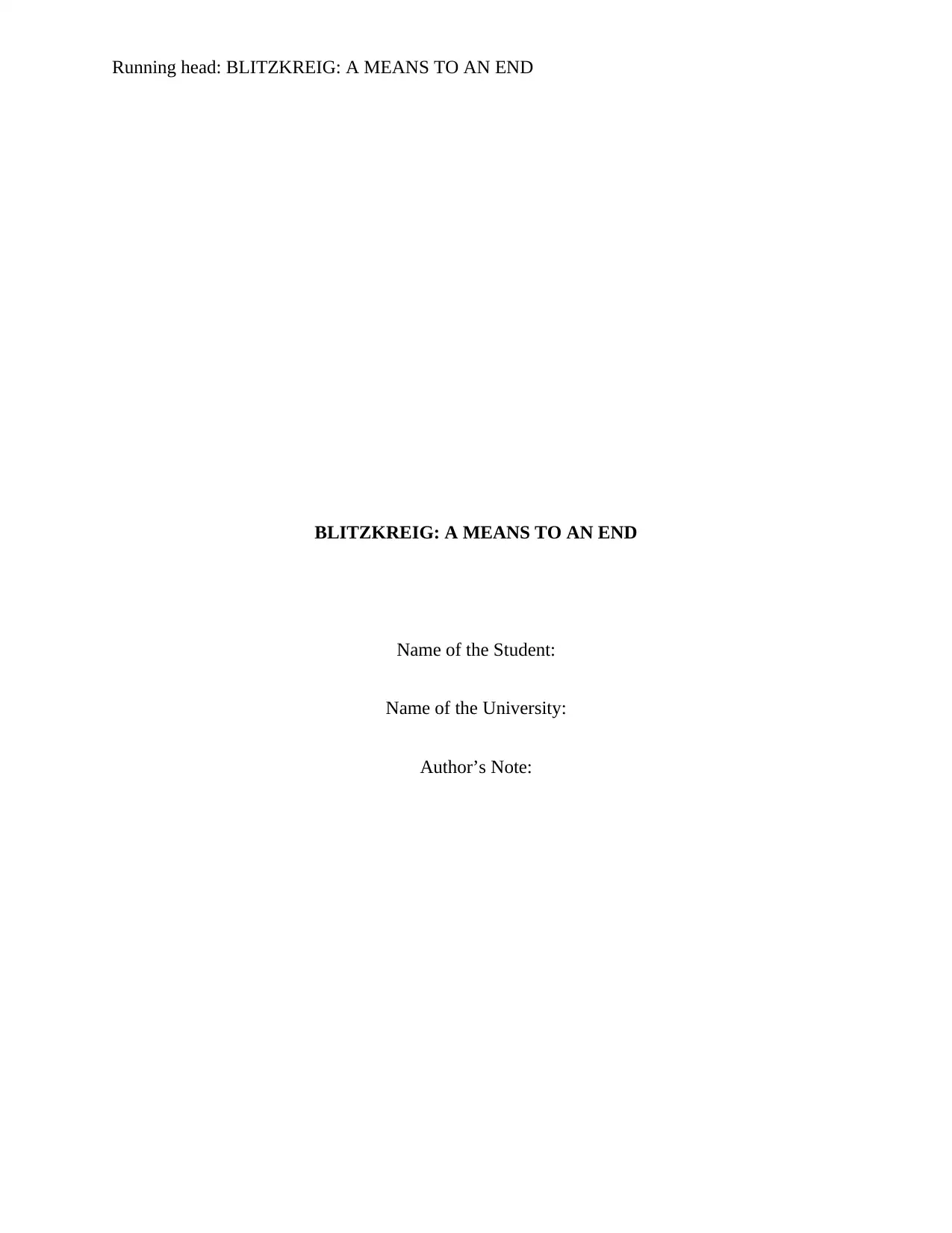
Running head: BLITZKREIG: A MEANS TO AN END
BLITZKREIG: A MEANS TO AN END
Name of the Student:
Name of the University:
Author’s Note:
BLITZKREIG: A MEANS TO AN END
Name of the Student:
Name of the University:
Author’s Note:
Paraphrase This Document
Need a fresh take? Get an instant paraphrase of this document with our AI Paraphraser
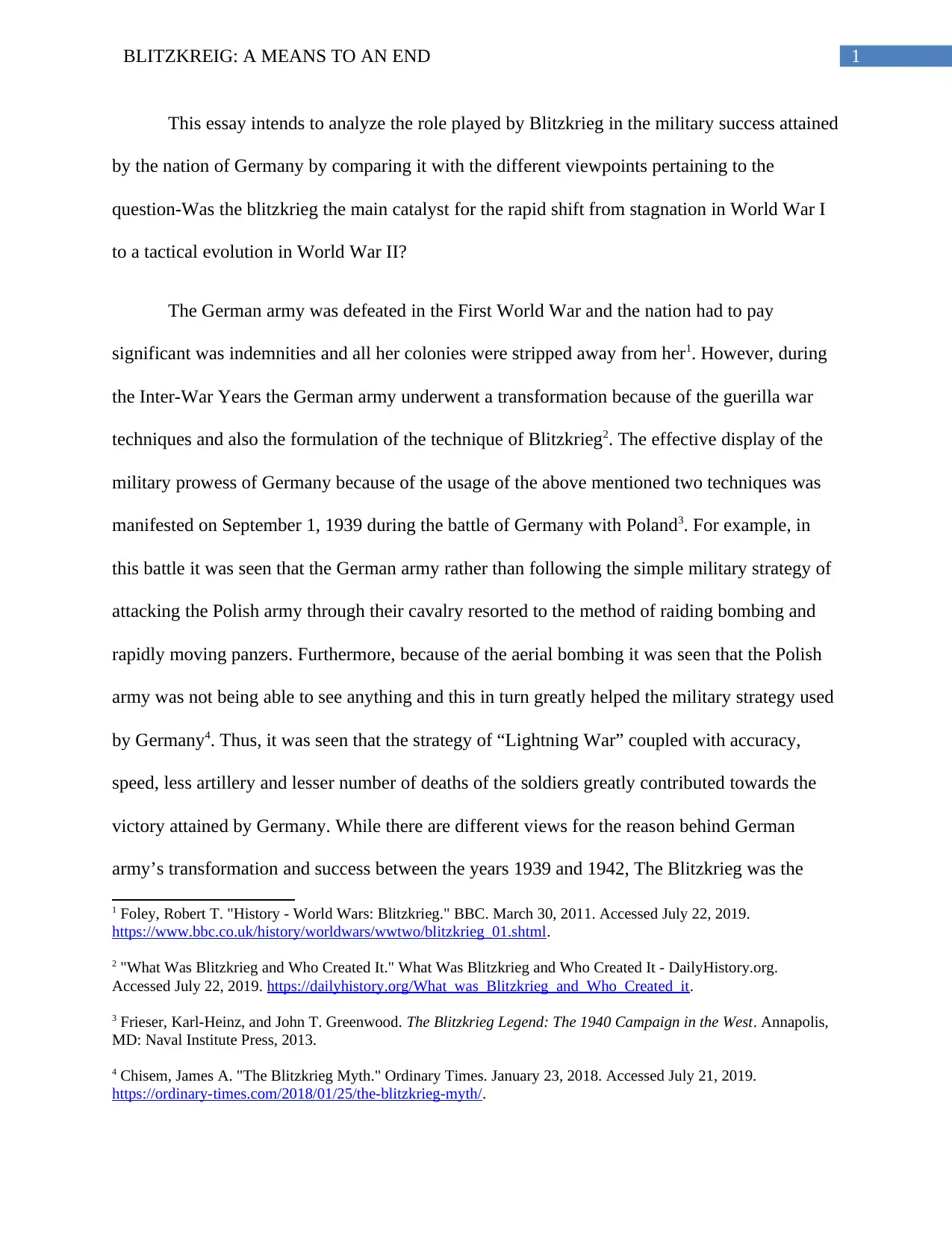
1BLITZKREIG: A MEANS TO AN END
This essay intends to analyze the role played by Blitzkrieg in the military success attained
by the nation of Germany by comparing it with the different viewpoints pertaining to the
question-Was the blitzkrieg the main catalyst for the rapid shift from stagnation in World War I
to a tactical evolution in World War II?
The German army was defeated in the First World War and the nation had to pay
significant was indemnities and all her colonies were stripped away from her1. However, during
the Inter-War Years the German army underwent a transformation because of the guerilla war
techniques and also the formulation of the technique of Blitzkrieg2. The effective display of the
military prowess of Germany because of the usage of the above mentioned two techniques was
manifested on September 1, 1939 during the battle of Germany with Poland3. For example, in
this battle it was seen that the German army rather than following the simple military strategy of
attacking the Polish army through their cavalry resorted to the method of raiding bombing and
rapidly moving panzers. Furthermore, because of the aerial bombing it was seen that the Polish
army was not being able to see anything and this in turn greatly helped the military strategy used
by Germany4. Thus, it was seen that the strategy of “Lightning War” coupled with accuracy,
speed, less artillery and lesser number of deaths of the soldiers greatly contributed towards the
victory attained by Germany. While there are different views for the reason behind German
army’s transformation and success between the years 1939 and 1942, The Blitzkrieg was the
1 Foley, Robert T. "History - World Wars: Blitzkrieg." BBC. March 30, 2011. Accessed July 22, 2019.
https://www.bbc.co.uk/history/worldwars/wwtwo/blitzkrieg_01.shtml.
2 "What Was Blitzkrieg and Who Created It." What Was Blitzkrieg and Who Created It - DailyHistory.org.
Accessed July 22, 2019. https://dailyhistory.org/What_was_Blitzkrieg_and_Who_Created_it.
3 Frieser, Karl-Heinz, and John T. Greenwood. The Blitzkrieg Legend: The 1940 Campaign in the West. Annapolis,
MD: Naval Institute Press, 2013.
4 Chisem, James A. "The Blitzkrieg Myth." Ordinary Times. January 23, 2018. Accessed July 21, 2019.
https://ordinary-times.com/2018/01/25/the-blitzkrieg-myth/.
This essay intends to analyze the role played by Blitzkrieg in the military success attained
by the nation of Germany by comparing it with the different viewpoints pertaining to the
question-Was the blitzkrieg the main catalyst for the rapid shift from stagnation in World War I
to a tactical evolution in World War II?
The German army was defeated in the First World War and the nation had to pay
significant was indemnities and all her colonies were stripped away from her1. However, during
the Inter-War Years the German army underwent a transformation because of the guerilla war
techniques and also the formulation of the technique of Blitzkrieg2. The effective display of the
military prowess of Germany because of the usage of the above mentioned two techniques was
manifested on September 1, 1939 during the battle of Germany with Poland3. For example, in
this battle it was seen that the German army rather than following the simple military strategy of
attacking the Polish army through their cavalry resorted to the method of raiding bombing and
rapidly moving panzers. Furthermore, because of the aerial bombing it was seen that the Polish
army was not being able to see anything and this in turn greatly helped the military strategy used
by Germany4. Thus, it was seen that the strategy of “Lightning War” coupled with accuracy,
speed, less artillery and lesser number of deaths of the soldiers greatly contributed towards the
victory attained by Germany. While there are different views for the reason behind German
army’s transformation and success between the years 1939 and 1942, The Blitzkrieg was the
1 Foley, Robert T. "History - World Wars: Blitzkrieg." BBC. March 30, 2011. Accessed July 22, 2019.
https://www.bbc.co.uk/history/worldwars/wwtwo/blitzkrieg_01.shtml.
2 "What Was Blitzkrieg and Who Created It." What Was Blitzkrieg and Who Created It - DailyHistory.org.
Accessed July 22, 2019. https://dailyhistory.org/What_was_Blitzkrieg_and_Who_Created_it.
3 Frieser, Karl-Heinz, and John T. Greenwood. The Blitzkrieg Legend: The 1940 Campaign in the West. Annapolis,
MD: Naval Institute Press, 2013.
4 Chisem, James A. "The Blitzkrieg Myth." Ordinary Times. January 23, 2018. Accessed July 21, 2019.
https://ordinary-times.com/2018/01/25/the-blitzkrieg-myth/.
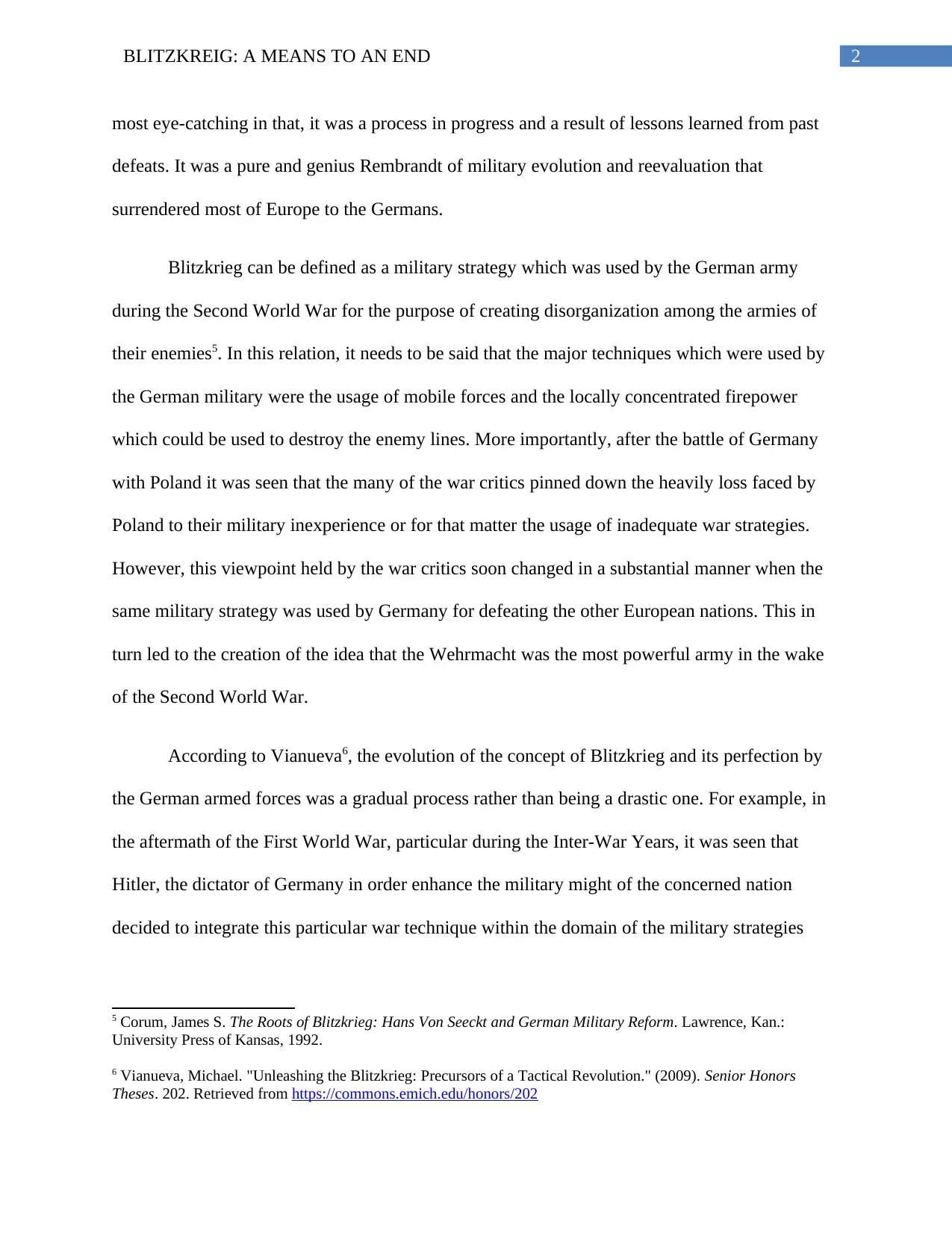
2BLITZKREIG: A MEANS TO AN END
most eye-catching in that, it was a process in progress and a result of lessons learned from past
defeats. It was a pure and genius Rembrandt of military evolution and reevaluation that
surrendered most of Europe to the Germans.
Blitzkrieg can be defined as a military strategy which was used by the German army
during the Second World War for the purpose of creating disorganization among the armies of
their enemies5. In this relation, it needs to be said that the major techniques which were used by
the German military were the usage of mobile forces and the locally concentrated firepower
which could be used to destroy the enemy lines. More importantly, after the battle of Germany
with Poland it was seen that the many of the war critics pinned down the heavily loss faced by
Poland to their military inexperience or for that matter the usage of inadequate war strategies.
However, this viewpoint held by the war critics soon changed in a substantial manner when the
same military strategy was used by Germany for defeating the other European nations. This in
turn led to the creation of the idea that the Wehrmacht was the most powerful army in the wake
of the Second World War.
According to Vianueva6, the evolution of the concept of Blitzkrieg and its perfection by
the German armed forces was a gradual process rather than being a drastic one. For example, in
the aftermath of the First World War, particular during the Inter-War Years, it was seen that
Hitler, the dictator of Germany in order enhance the military might of the concerned nation
decided to integrate this particular war technique within the domain of the military strategies
5 Corum, James S. The Roots of Blitzkrieg: Hans Von Seeckt and German Military Reform. Lawrence, Kan.:
University Press of Kansas, 1992.
6 Vianueva, Michael. "Unleashing the Blitzkrieg: Precursors of a Tactical Revolution." (2009). Senior Honors
Theses. 202. Retrieved from https://commons.emich.edu/honors/202
most eye-catching in that, it was a process in progress and a result of lessons learned from past
defeats. It was a pure and genius Rembrandt of military evolution and reevaluation that
surrendered most of Europe to the Germans.
Blitzkrieg can be defined as a military strategy which was used by the German army
during the Second World War for the purpose of creating disorganization among the armies of
their enemies5. In this relation, it needs to be said that the major techniques which were used by
the German military were the usage of mobile forces and the locally concentrated firepower
which could be used to destroy the enemy lines. More importantly, after the battle of Germany
with Poland it was seen that the many of the war critics pinned down the heavily loss faced by
Poland to their military inexperience or for that matter the usage of inadequate war strategies.
However, this viewpoint held by the war critics soon changed in a substantial manner when the
same military strategy was used by Germany for defeating the other European nations. This in
turn led to the creation of the idea that the Wehrmacht was the most powerful army in the wake
of the Second World War.
According to Vianueva6, the evolution of the concept of Blitzkrieg and its perfection by
the German armed forces was a gradual process rather than being a drastic one. For example, in
the aftermath of the First World War, particular during the Inter-War Years, it was seen that
Hitler, the dictator of Germany in order enhance the military might of the concerned nation
decided to integrate this particular war technique within the domain of the military strategies
5 Corum, James S. The Roots of Blitzkrieg: Hans Von Seeckt and German Military Reform. Lawrence, Kan.:
University Press of Kansas, 1992.
6 Vianueva, Michael. "Unleashing the Blitzkrieg: Precursors of a Tactical Revolution." (2009). Senior Honors
Theses. 202. Retrieved from https://commons.emich.edu/honors/202
⊘ This is a preview!⊘
Do you want full access?
Subscribe today to unlock all pages.

Trusted by 1+ million students worldwide
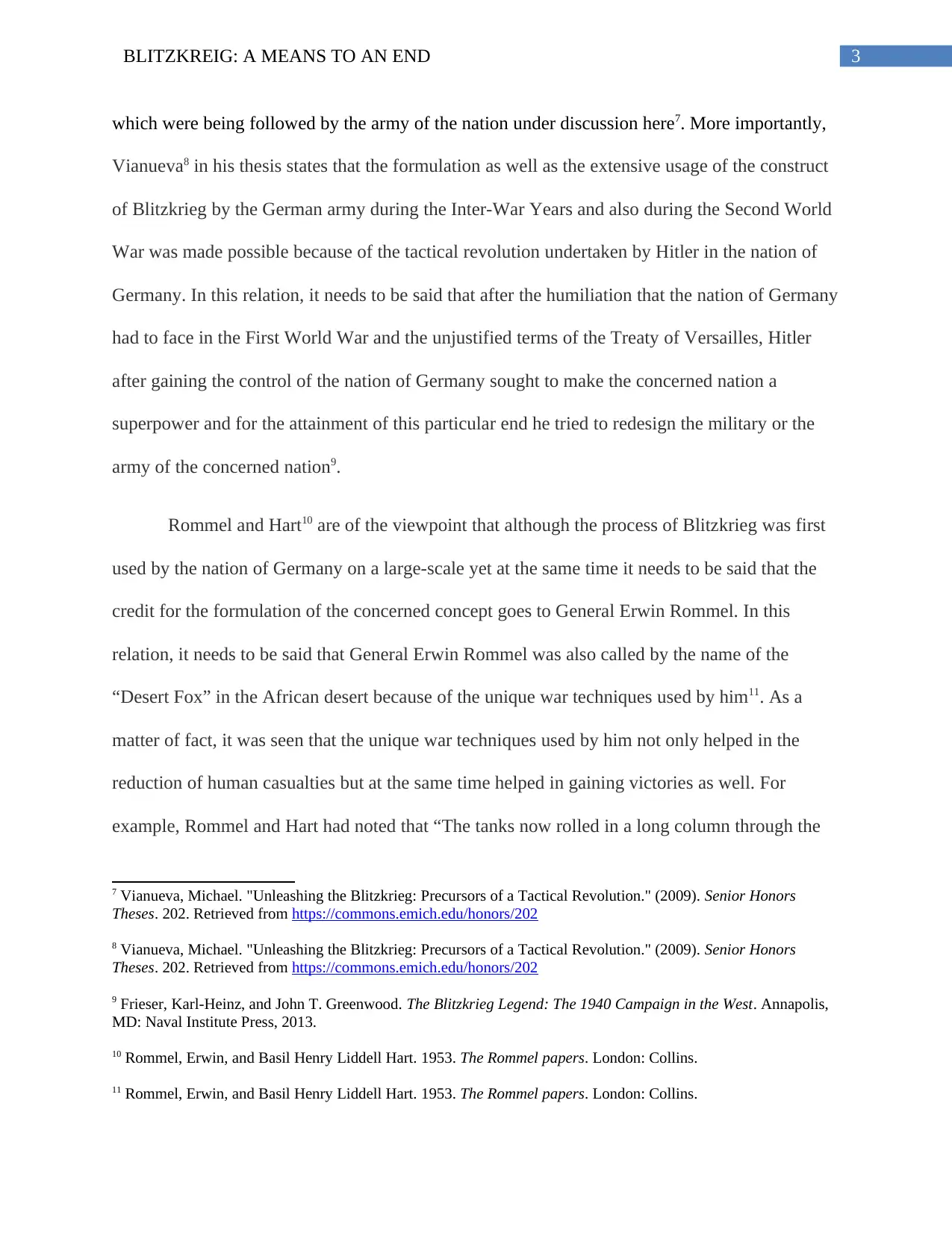
3BLITZKREIG: A MEANS TO AN END
which were being followed by the army of the nation under discussion here7. More importantly,
Vianueva8 in his thesis states that the formulation as well as the extensive usage of the construct
of Blitzkrieg by the German army during the Inter-War Years and also during the Second World
War was made possible because of the tactical revolution undertaken by Hitler in the nation of
Germany. In this relation, it needs to be said that after the humiliation that the nation of Germany
had to face in the First World War and the unjustified terms of the Treaty of Versailles, Hitler
after gaining the control of the nation of Germany sought to make the concerned nation a
superpower and for the attainment of this particular end he tried to redesign the military or the
army of the concerned nation9.
Rommel and Hart10 are of the viewpoint that although the process of Blitzkrieg was first
used by the nation of Germany on a large-scale yet at the same time it needs to be said that the
credit for the formulation of the concerned concept goes to General Erwin Rommel. In this
relation, it needs to be said that General Erwin Rommel was also called by the name of the
“Desert Fox” in the African desert because of the unique war techniques used by him11. As a
matter of fact, it was seen that the unique war techniques used by him not only helped in the
reduction of human casualties but at the same time helped in gaining victories as well. For
example, Rommel and Hart had noted that “The tanks now rolled in a long column through the
7 Vianueva, Michael. "Unleashing the Blitzkrieg: Precursors of a Tactical Revolution." (2009). Senior Honors
Theses. 202. Retrieved from https://commons.emich.edu/honors/202
8 Vianueva, Michael. "Unleashing the Blitzkrieg: Precursors of a Tactical Revolution." (2009). Senior Honors
Theses. 202. Retrieved from https://commons.emich.edu/honors/202
9 Frieser, Karl-Heinz, and John T. Greenwood. The Blitzkrieg Legend: The 1940 Campaign in the West. Annapolis,
MD: Naval Institute Press, 2013.
10 Rommel, Erwin, and Basil Henry Liddell Hart. 1953. The Rommel papers. London: Collins.
11 Rommel, Erwin, and Basil Henry Liddell Hart. 1953. The Rommel papers. London: Collins.
which were being followed by the army of the nation under discussion here7. More importantly,
Vianueva8 in his thesis states that the formulation as well as the extensive usage of the construct
of Blitzkrieg by the German army during the Inter-War Years and also during the Second World
War was made possible because of the tactical revolution undertaken by Hitler in the nation of
Germany. In this relation, it needs to be said that after the humiliation that the nation of Germany
had to face in the First World War and the unjustified terms of the Treaty of Versailles, Hitler
after gaining the control of the nation of Germany sought to make the concerned nation a
superpower and for the attainment of this particular end he tried to redesign the military or the
army of the concerned nation9.
Rommel and Hart10 are of the viewpoint that although the process of Blitzkrieg was first
used by the nation of Germany on a large-scale yet at the same time it needs to be said that the
credit for the formulation of the concerned concept goes to General Erwin Rommel. In this
relation, it needs to be said that General Erwin Rommel was also called by the name of the
“Desert Fox” in the African desert because of the unique war techniques used by him11. As a
matter of fact, it was seen that the unique war techniques used by him not only helped in the
reduction of human casualties but at the same time helped in gaining victories as well. For
example, Rommel and Hart had noted that “The tanks now rolled in a long column through the
7 Vianueva, Michael. "Unleashing the Blitzkrieg: Precursors of a Tactical Revolution." (2009). Senior Honors
Theses. 202. Retrieved from https://commons.emich.edu/honors/202
8 Vianueva, Michael. "Unleashing the Blitzkrieg: Precursors of a Tactical Revolution." (2009). Senior Honors
Theses. 202. Retrieved from https://commons.emich.edu/honors/202
9 Frieser, Karl-Heinz, and John T. Greenwood. The Blitzkrieg Legend: The 1940 Campaign in the West. Annapolis,
MD: Naval Institute Press, 2013.
10 Rommel, Erwin, and Basil Henry Liddell Hart. 1953. The Rommel papers. London: Collins.
11 Rommel, Erwin, and Basil Henry Liddell Hart. 1953. The Rommel papers. London: Collins.
Paraphrase This Document
Need a fresh take? Get an instant paraphrase of this document with our AI Paraphraser
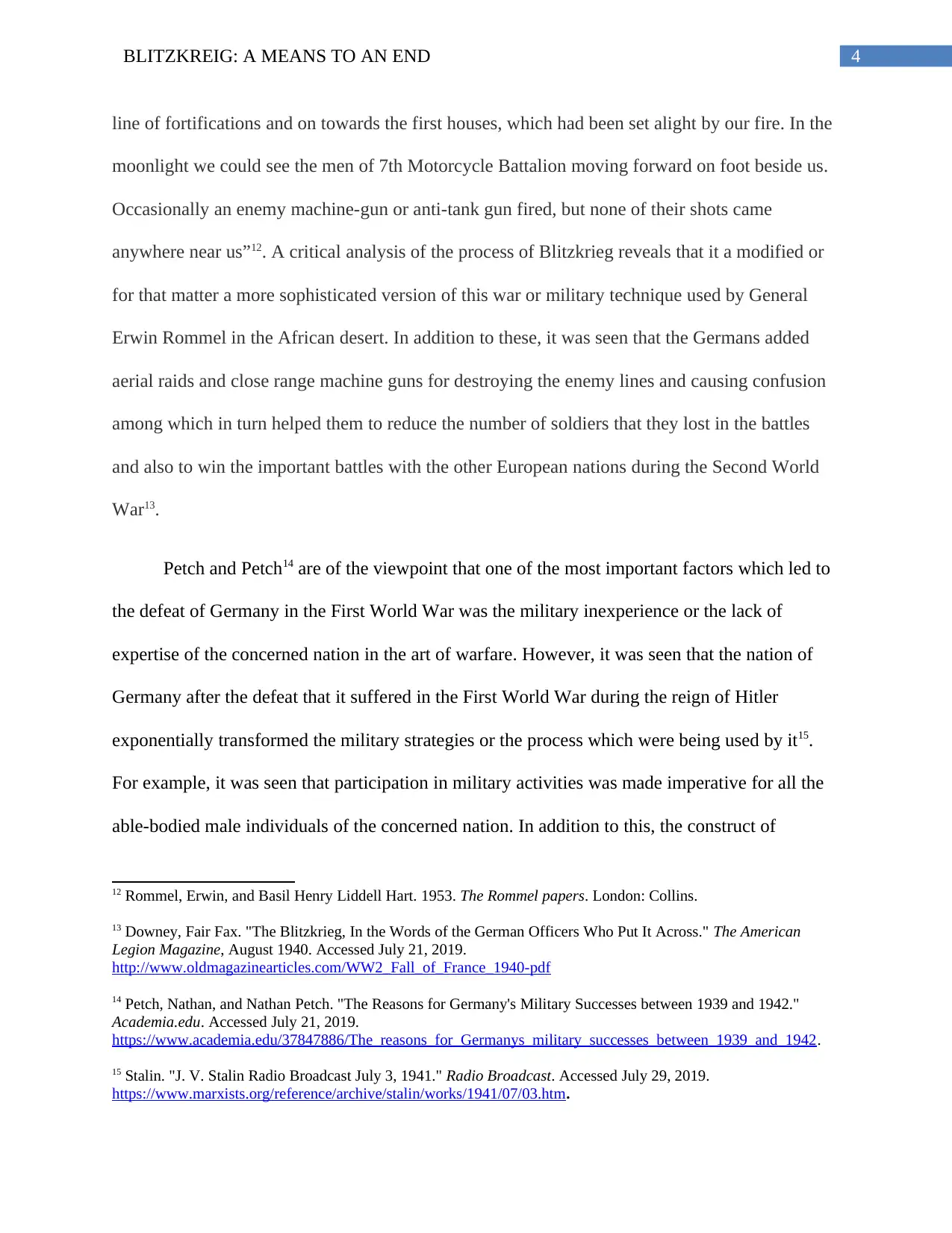
4BLITZKREIG: A MEANS TO AN END
line of fortifications and on towards the first houses, which had been set alight by our fire. In the
moonlight we could see the men of 7th Motorcycle Battalion moving forward on foot beside us.
Occasionally an enemy machine-gun or anti-tank gun fired, but none of their shots came
anywhere near us”12. A critical analysis of the process of Blitzkrieg reveals that it a modified or
for that matter a more sophisticated version of this war or military technique used by General
Erwin Rommel in the African desert. In addition to these, it was seen that the Germans added
aerial raids and close range machine guns for destroying the enemy lines and causing confusion
among which in turn helped them to reduce the number of soldiers that they lost in the battles
and also to win the important battles with the other European nations during the Second World
War13.
Petch and Petch14 are of the viewpoint that one of the most important factors which led to
the defeat of Germany in the First World War was the military inexperience or the lack of
expertise of the concerned nation in the art of warfare. However, it was seen that the nation of
Germany after the defeat that it suffered in the First World War during the reign of Hitler
exponentially transformed the military strategies or the process which were being used by it15.
For example, it was seen that participation in military activities was made imperative for all the
able-bodied male individuals of the concerned nation. In addition to this, the construct of
12 Rommel, Erwin, and Basil Henry Liddell Hart. 1953. The Rommel papers. London: Collins.
13 Downey, Fair Fax. "The Blitzkrieg, In the Words of the German Officers Who Put It Across." The American
Legion Magazine, August 1940. Accessed July 21, 2019.
http://www.oldmagazinearticles.com/WW2_Fall_of_France_1940-pdf
14 Petch, Nathan, and Nathan Petch. "The Reasons for Germany's Military Successes between 1939 and 1942."
Academia.edu. Accessed July 21, 2019.
https://www.academia.edu/37847886/The_reasons_for_Germanys_military_successes_between_1939_and_1942.
15 Stalin. "J. V. Stalin Radio Broadcast July 3, 1941." Radio Broadcast. Accessed July 29, 2019.
https://www.marxists.org/reference/archive/stalin/works/1941/07/03.htm.
line of fortifications and on towards the first houses, which had been set alight by our fire. In the
moonlight we could see the men of 7th Motorcycle Battalion moving forward on foot beside us.
Occasionally an enemy machine-gun or anti-tank gun fired, but none of their shots came
anywhere near us”12. A critical analysis of the process of Blitzkrieg reveals that it a modified or
for that matter a more sophisticated version of this war or military technique used by General
Erwin Rommel in the African desert. In addition to these, it was seen that the Germans added
aerial raids and close range machine guns for destroying the enemy lines and causing confusion
among which in turn helped them to reduce the number of soldiers that they lost in the battles
and also to win the important battles with the other European nations during the Second World
War13.
Petch and Petch14 are of the viewpoint that one of the most important factors which led to
the defeat of Germany in the First World War was the military inexperience or the lack of
expertise of the concerned nation in the art of warfare. However, it was seen that the nation of
Germany after the defeat that it suffered in the First World War during the reign of Hitler
exponentially transformed the military strategies or the process which were being used by it15.
For example, it was seen that participation in military activities was made imperative for all the
able-bodied male individuals of the concerned nation. In addition to this, the construct of
12 Rommel, Erwin, and Basil Henry Liddell Hart. 1953. The Rommel papers. London: Collins.
13 Downey, Fair Fax. "The Blitzkrieg, In the Words of the German Officers Who Put It Across." The American
Legion Magazine, August 1940. Accessed July 21, 2019.
http://www.oldmagazinearticles.com/WW2_Fall_of_France_1940-pdf
14 Petch, Nathan, and Nathan Petch. "The Reasons for Germany's Military Successes between 1939 and 1942."
Academia.edu. Accessed July 21, 2019.
https://www.academia.edu/37847886/The_reasons_for_Germanys_military_successes_between_1939_and_1942.
15 Stalin. "J. V. Stalin Radio Broadcast July 3, 1941." Radio Broadcast. Accessed July 29, 2019.
https://www.marxists.org/reference/archive/stalin/works/1941/07/03.htm.
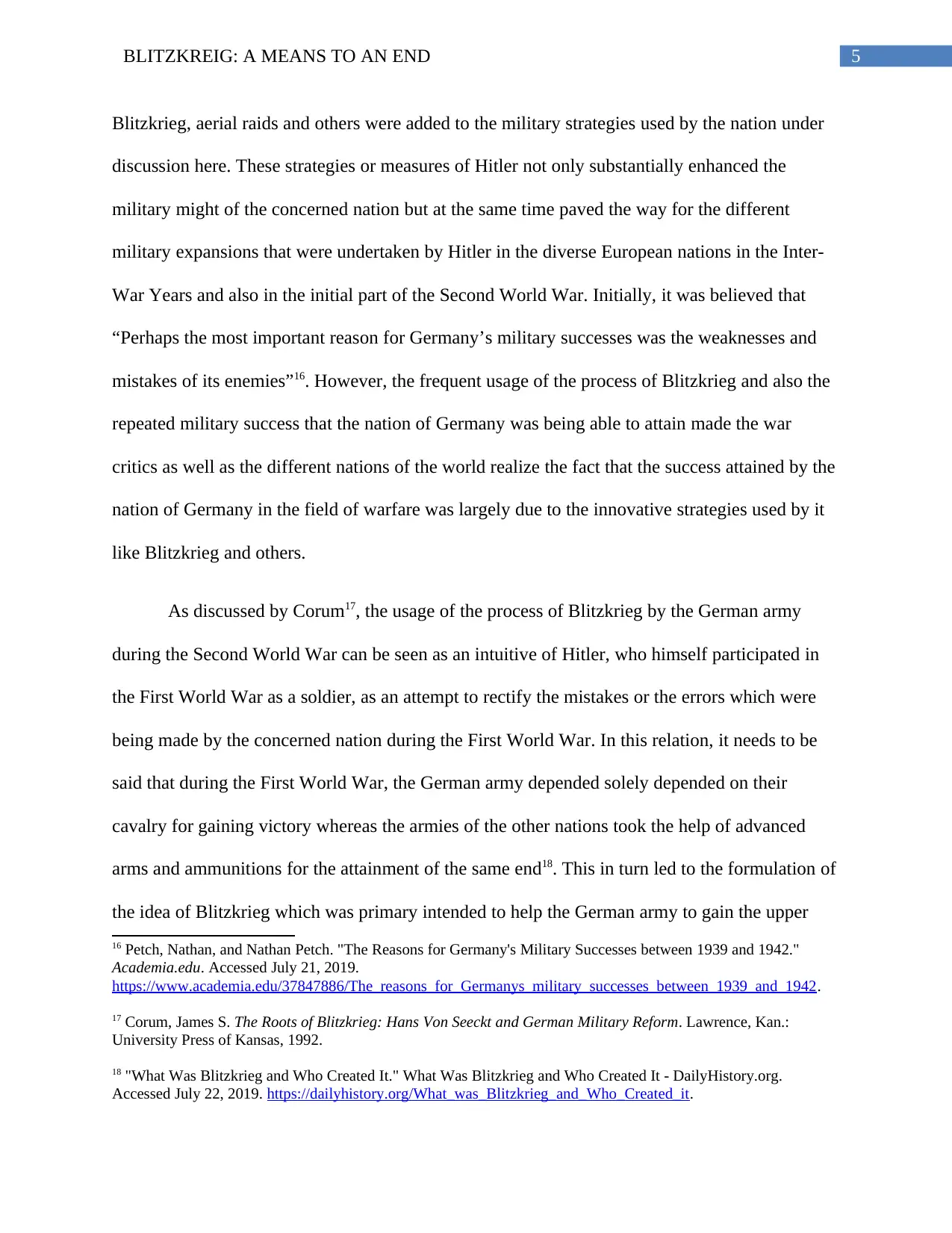
5BLITZKREIG: A MEANS TO AN END
Blitzkrieg, aerial raids and others were added to the military strategies used by the nation under
discussion here. These strategies or measures of Hitler not only substantially enhanced the
military might of the concerned nation but at the same time paved the way for the different
military expansions that were undertaken by Hitler in the diverse European nations in the Inter-
War Years and also in the initial part of the Second World War. Initially, it was believed that
“Perhaps the most important reason for Germany’s military successes was the weaknesses and
mistakes of its enemies”16. However, the frequent usage of the process of Blitzkrieg and also the
repeated military success that the nation of Germany was being able to attain made the war
critics as well as the different nations of the world realize the fact that the success attained by the
nation of Germany in the field of warfare was largely due to the innovative strategies used by it
like Blitzkrieg and others.
As discussed by Corum17, the usage of the process of Blitzkrieg by the German army
during the Second World War can be seen as an intuitive of Hitler, who himself participated in
the First World War as a soldier, as an attempt to rectify the mistakes or the errors which were
being made by the concerned nation during the First World War. In this relation, it needs to be
said that during the First World War, the German army depended solely depended on their
cavalry for gaining victory whereas the armies of the other nations took the help of advanced
arms and ammunitions for the attainment of the same end18. This in turn led to the formulation of
the idea of Blitzkrieg which was primary intended to help the German army to gain the upper
16 Petch, Nathan, and Nathan Petch. "The Reasons for Germany's Military Successes between 1939 and 1942."
Academia.edu. Accessed July 21, 2019.
https://www.academia.edu/37847886/The_reasons_for_Germanys_military_successes_between_1939_and_1942.
17 Corum, James S. The Roots of Blitzkrieg: Hans Von Seeckt and German Military Reform. Lawrence, Kan.:
University Press of Kansas, 1992.
18 "What Was Blitzkrieg and Who Created It." What Was Blitzkrieg and Who Created It - DailyHistory.org.
Accessed July 22, 2019. https://dailyhistory.org/What_was_Blitzkrieg_and_Who_Created_it.
Blitzkrieg, aerial raids and others were added to the military strategies used by the nation under
discussion here. These strategies or measures of Hitler not only substantially enhanced the
military might of the concerned nation but at the same time paved the way for the different
military expansions that were undertaken by Hitler in the diverse European nations in the Inter-
War Years and also in the initial part of the Second World War. Initially, it was believed that
“Perhaps the most important reason for Germany’s military successes was the weaknesses and
mistakes of its enemies”16. However, the frequent usage of the process of Blitzkrieg and also the
repeated military success that the nation of Germany was being able to attain made the war
critics as well as the different nations of the world realize the fact that the success attained by the
nation of Germany in the field of warfare was largely due to the innovative strategies used by it
like Blitzkrieg and others.
As discussed by Corum17, the usage of the process of Blitzkrieg by the German army
during the Second World War can be seen as an intuitive of Hitler, who himself participated in
the First World War as a soldier, as an attempt to rectify the mistakes or the errors which were
being made by the concerned nation during the First World War. In this relation, it needs to be
said that during the First World War, the German army depended solely depended on their
cavalry for gaining victory whereas the armies of the other nations took the help of advanced
arms and ammunitions for the attainment of the same end18. This in turn led to the formulation of
the idea of Blitzkrieg which was primary intended to help the German army to gain the upper
16 Petch, Nathan, and Nathan Petch. "The Reasons for Germany's Military Successes between 1939 and 1942."
Academia.edu. Accessed July 21, 2019.
https://www.academia.edu/37847886/The_reasons_for_Germanys_military_successes_between_1939_and_1942.
17 Corum, James S. The Roots of Blitzkrieg: Hans Von Seeckt and German Military Reform. Lawrence, Kan.:
University Press of Kansas, 1992.
18 "What Was Blitzkrieg and Who Created It." What Was Blitzkrieg and Who Created It - DailyHistory.org.
Accessed July 22, 2019. https://dailyhistory.org/What_was_Blitzkrieg_and_Who_Created_it.
⊘ This is a preview!⊘
Do you want full access?
Subscribe today to unlock all pages.

Trusted by 1+ million students worldwide
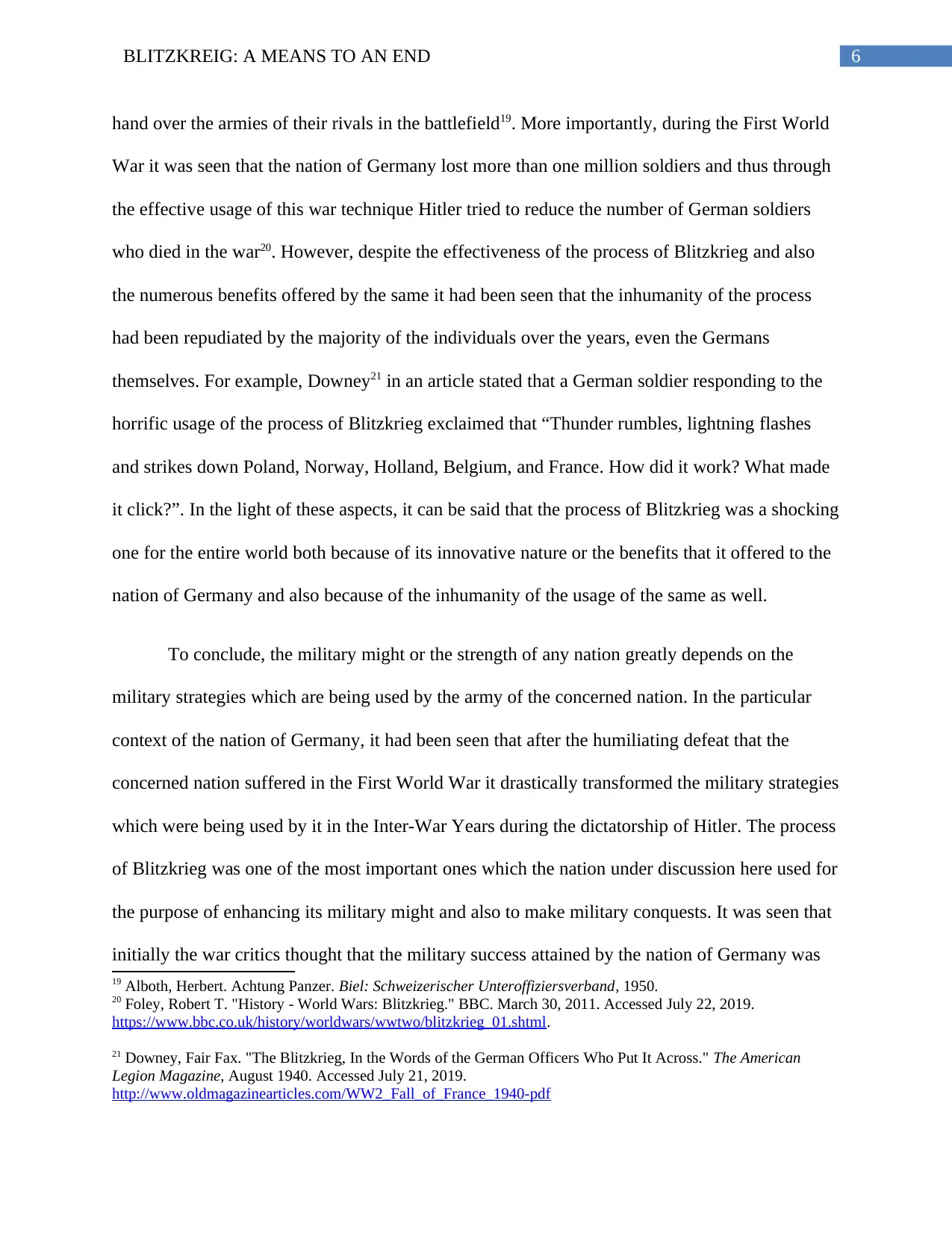
6BLITZKREIG: A MEANS TO AN END
hand over the armies of their rivals in the battlefield19. More importantly, during the First World
War it was seen that the nation of Germany lost more than one million soldiers and thus through
the effective usage of this war technique Hitler tried to reduce the number of German soldiers
who died in the war20. However, despite the effectiveness of the process of Blitzkrieg and also
the numerous benefits offered by the same it had been seen that the inhumanity of the process
had been repudiated by the majority of the individuals over the years, even the Germans
themselves. For example, Downey21 in an article stated that a German soldier responding to the
horrific usage of the process of Blitzkrieg exclaimed that “Thunder rumbles, lightning flashes
and strikes down Poland, Norway, Holland, Belgium, and France. How did it work? What made
it click?”. In the light of these aspects, it can be said that the process of Blitzkrieg was a shocking
one for the entire world both because of its innovative nature or the benefits that it offered to the
nation of Germany and also because of the inhumanity of the usage of the same as well.
To conclude, the military might or the strength of any nation greatly depends on the
military strategies which are being used by the army of the concerned nation. In the particular
context of the nation of Germany, it had been seen that after the humiliating defeat that the
concerned nation suffered in the First World War it drastically transformed the military strategies
which were being used by it in the Inter-War Years during the dictatorship of Hitler. The process
of Blitzkrieg was one of the most important ones which the nation under discussion here used for
the purpose of enhancing its military might and also to make military conquests. It was seen that
initially the war critics thought that the military success attained by the nation of Germany was
19 Alboth, Herbert. Achtung Panzer. Biel: Schweizerischer Unteroffiziersverband, 1950.
20 Foley, Robert T. "History - World Wars: Blitzkrieg." BBC. March 30, 2011. Accessed July 22, 2019.
https://www.bbc.co.uk/history/worldwars/wwtwo/blitzkrieg_01.shtml.
21 Downey, Fair Fax. "The Blitzkrieg, In the Words of the German Officers Who Put It Across." The American
Legion Magazine, August 1940. Accessed July 21, 2019.
http://www.oldmagazinearticles.com/WW2_Fall_of_France_1940-pdf
hand over the armies of their rivals in the battlefield19. More importantly, during the First World
War it was seen that the nation of Germany lost more than one million soldiers and thus through
the effective usage of this war technique Hitler tried to reduce the number of German soldiers
who died in the war20. However, despite the effectiveness of the process of Blitzkrieg and also
the numerous benefits offered by the same it had been seen that the inhumanity of the process
had been repudiated by the majority of the individuals over the years, even the Germans
themselves. For example, Downey21 in an article stated that a German soldier responding to the
horrific usage of the process of Blitzkrieg exclaimed that “Thunder rumbles, lightning flashes
and strikes down Poland, Norway, Holland, Belgium, and France. How did it work? What made
it click?”. In the light of these aspects, it can be said that the process of Blitzkrieg was a shocking
one for the entire world both because of its innovative nature or the benefits that it offered to the
nation of Germany and also because of the inhumanity of the usage of the same as well.
To conclude, the military might or the strength of any nation greatly depends on the
military strategies which are being used by the army of the concerned nation. In the particular
context of the nation of Germany, it had been seen that after the humiliating defeat that the
concerned nation suffered in the First World War it drastically transformed the military strategies
which were being used by it in the Inter-War Years during the dictatorship of Hitler. The process
of Blitzkrieg was one of the most important ones which the nation under discussion here used for
the purpose of enhancing its military might and also to make military conquests. It was seen that
initially the war critics thought that the military success attained by the nation of Germany was
19 Alboth, Herbert. Achtung Panzer. Biel: Schweizerischer Unteroffiziersverband, 1950.
20 Foley, Robert T. "History - World Wars: Blitzkrieg." BBC. March 30, 2011. Accessed July 22, 2019.
https://www.bbc.co.uk/history/worldwars/wwtwo/blitzkrieg_01.shtml.
21 Downey, Fair Fax. "The Blitzkrieg, In the Words of the German Officers Who Put It Across." The American
Legion Magazine, August 1940. Accessed July 21, 2019.
http://www.oldmagazinearticles.com/WW2_Fall_of_France_1940-pdf
Paraphrase This Document
Need a fresh take? Get an instant paraphrase of this document with our AI Paraphraser
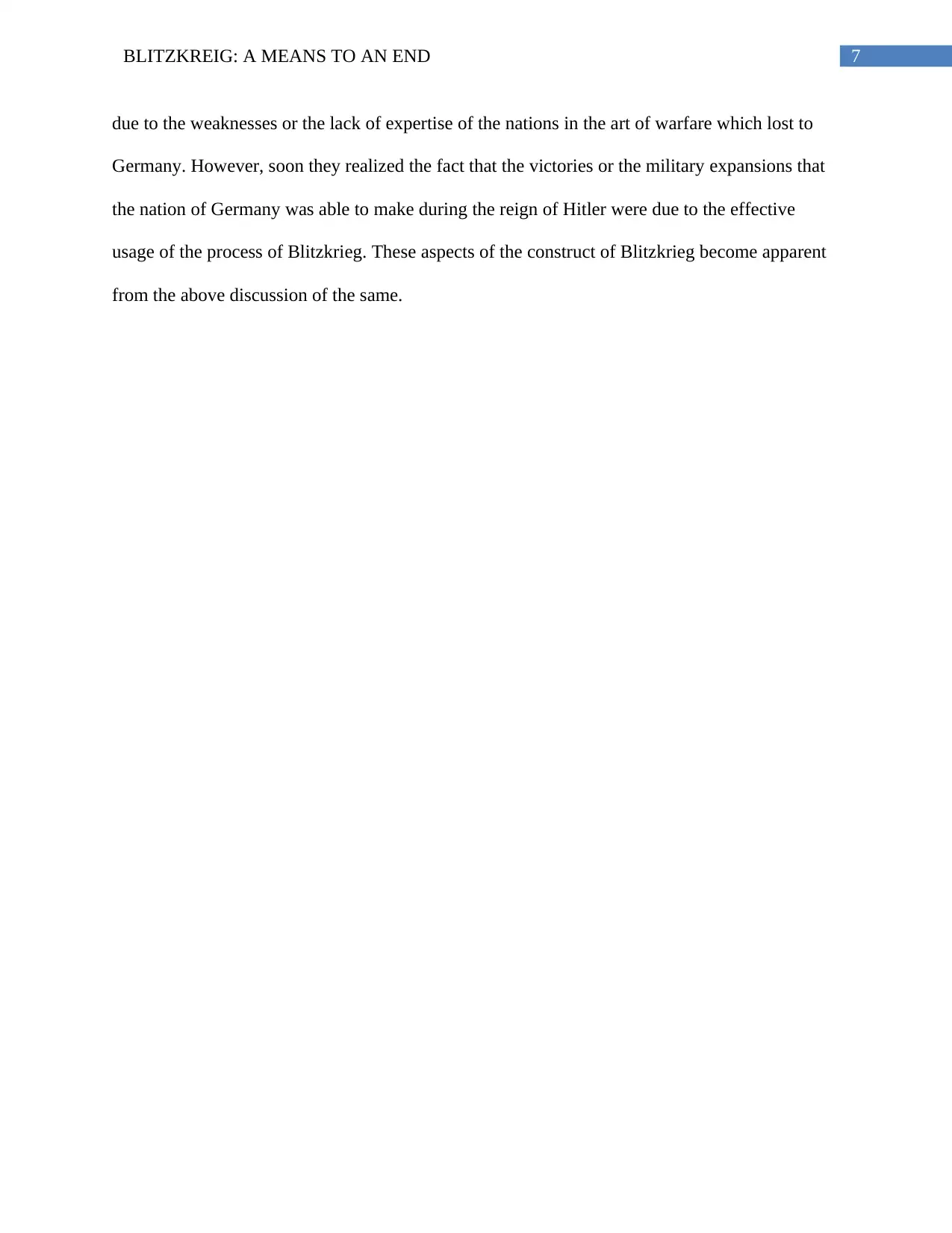
7BLITZKREIG: A MEANS TO AN END
due to the weaknesses or the lack of expertise of the nations in the art of warfare which lost to
Germany. However, soon they realized the fact that the victories or the military expansions that
the nation of Germany was able to make during the reign of Hitler were due to the effective
usage of the process of Blitzkrieg. These aspects of the construct of Blitzkrieg become apparent
from the above discussion of the same.
due to the weaknesses or the lack of expertise of the nations in the art of warfare which lost to
Germany. However, soon they realized the fact that the victories or the military expansions that
the nation of Germany was able to make during the reign of Hitler were due to the effective
usage of the process of Blitzkrieg. These aspects of the construct of Blitzkrieg become apparent
from the above discussion of the same.
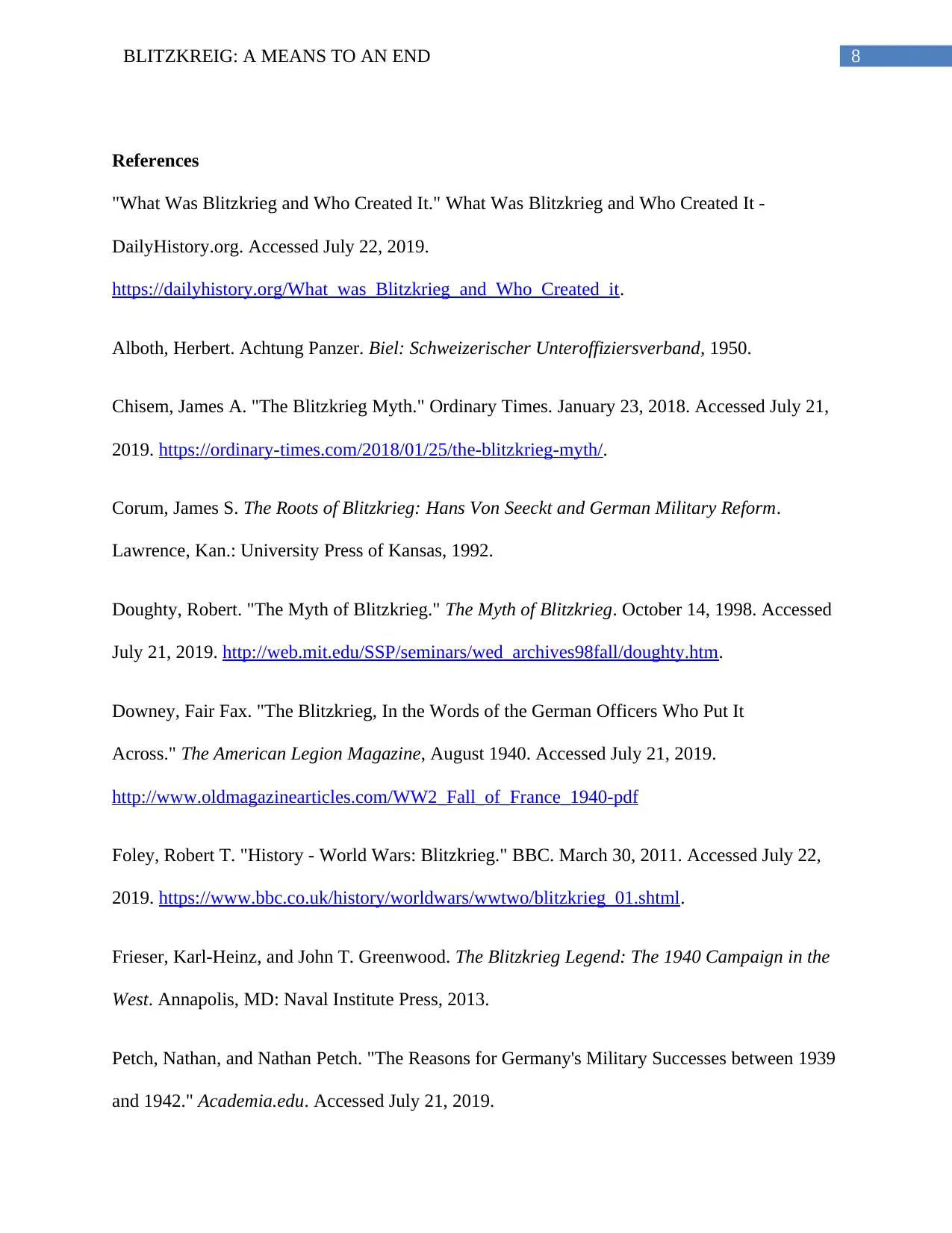
8BLITZKREIG: A MEANS TO AN END
References
"What Was Blitzkrieg and Who Created It." What Was Blitzkrieg and Who Created It -
DailyHistory.org. Accessed July 22, 2019.
https://dailyhistory.org/What_was_Blitzkrieg_and_Who_Created_it.
Alboth, Herbert. Achtung Panzer. Biel: Schweizerischer Unteroffiziersverband, 1950.
Chisem, James A. "The Blitzkrieg Myth." Ordinary Times. January 23, 2018. Accessed July 21,
2019. https://ordinary-times.com/2018/01/25/the-blitzkrieg-myth/.
Corum, James S. The Roots of Blitzkrieg: Hans Von Seeckt and German Military Reform.
Lawrence, Kan.: University Press of Kansas, 1992.
Doughty, Robert. "The Myth of Blitzkrieg." The Myth of Blitzkrieg. October 14, 1998. Accessed
July 21, 2019. http://web.mit.edu/SSP/seminars/wed_archives98fall/doughty.htm.
Downey, Fair Fax. "The Blitzkrieg, In the Words of the German Officers Who Put It
Across." The American Legion Magazine, August 1940. Accessed July 21, 2019.
http://www.oldmagazinearticles.com/WW2_Fall_of_France_1940-pdf
Foley, Robert T. "History - World Wars: Blitzkrieg." BBC. March 30, 2011. Accessed July 22,
2019. https://www.bbc.co.uk/history/worldwars/wwtwo/blitzkrieg_01.shtml.
Frieser, Karl-Heinz, and John T. Greenwood. The Blitzkrieg Legend: The 1940 Campaign in the
West. Annapolis, MD: Naval Institute Press, 2013.
Petch, Nathan, and Nathan Petch. "The Reasons for Germany's Military Successes between 1939
and 1942." Academia.edu. Accessed July 21, 2019.
References
"What Was Blitzkrieg and Who Created It." What Was Blitzkrieg and Who Created It -
DailyHistory.org. Accessed July 22, 2019.
https://dailyhistory.org/What_was_Blitzkrieg_and_Who_Created_it.
Alboth, Herbert. Achtung Panzer. Biel: Schweizerischer Unteroffiziersverband, 1950.
Chisem, James A. "The Blitzkrieg Myth." Ordinary Times. January 23, 2018. Accessed July 21,
2019. https://ordinary-times.com/2018/01/25/the-blitzkrieg-myth/.
Corum, James S. The Roots of Blitzkrieg: Hans Von Seeckt and German Military Reform.
Lawrence, Kan.: University Press of Kansas, 1992.
Doughty, Robert. "The Myth of Blitzkrieg." The Myth of Blitzkrieg. October 14, 1998. Accessed
July 21, 2019. http://web.mit.edu/SSP/seminars/wed_archives98fall/doughty.htm.
Downey, Fair Fax. "The Blitzkrieg, In the Words of the German Officers Who Put It
Across." The American Legion Magazine, August 1940. Accessed July 21, 2019.
http://www.oldmagazinearticles.com/WW2_Fall_of_France_1940-pdf
Foley, Robert T. "History - World Wars: Blitzkrieg." BBC. March 30, 2011. Accessed July 22,
2019. https://www.bbc.co.uk/history/worldwars/wwtwo/blitzkrieg_01.shtml.
Frieser, Karl-Heinz, and John T. Greenwood. The Blitzkrieg Legend: The 1940 Campaign in the
West. Annapolis, MD: Naval Institute Press, 2013.
Petch, Nathan, and Nathan Petch. "The Reasons for Germany's Military Successes between 1939
and 1942." Academia.edu. Accessed July 21, 2019.
⊘ This is a preview!⊘
Do you want full access?
Subscribe today to unlock all pages.

Trusted by 1+ million students worldwide
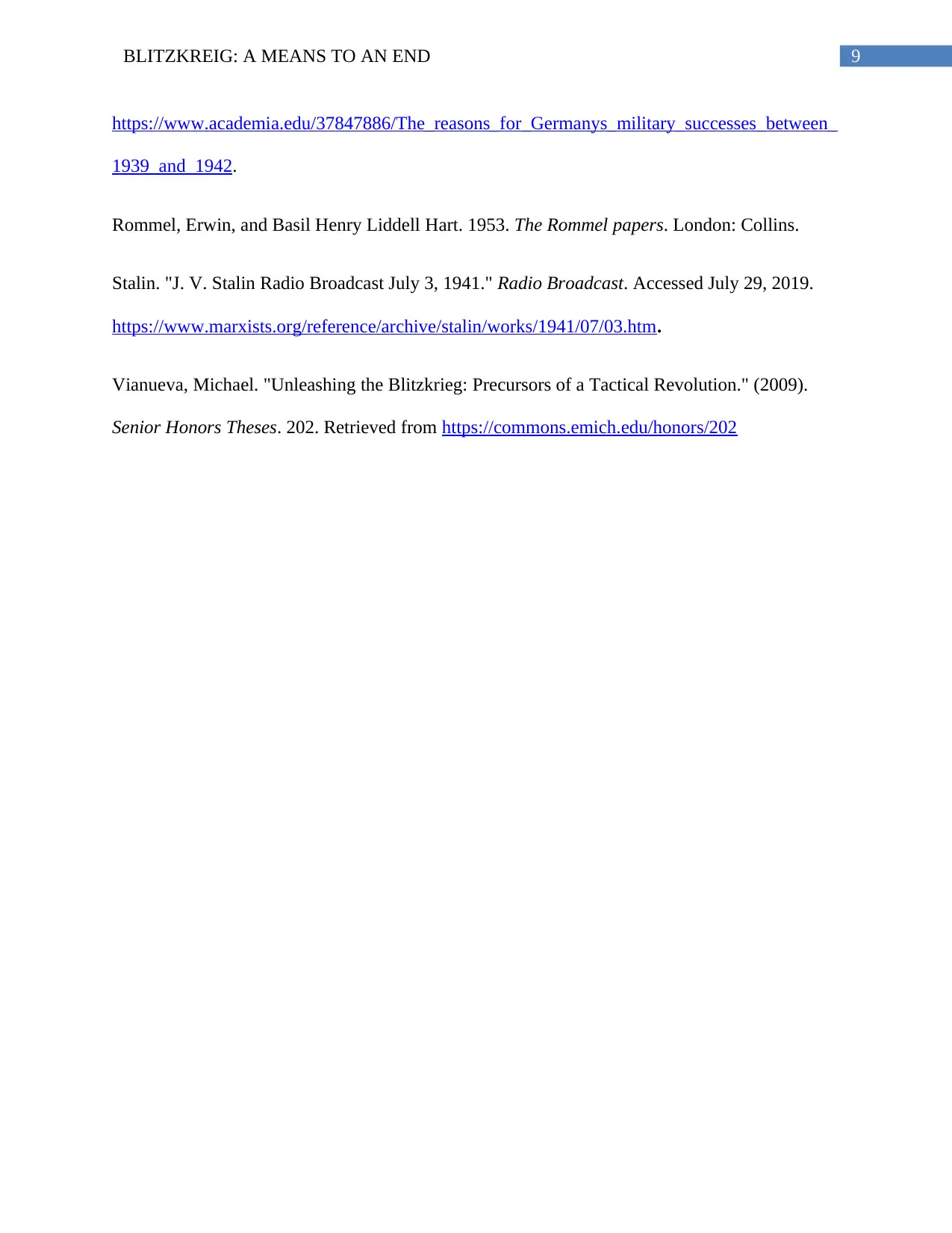
9BLITZKREIG: A MEANS TO AN END
https://www.academia.edu/37847886/The_reasons_for_Germanys_military_successes_between_
1939_and_1942.
Rommel, Erwin, and Basil Henry Liddell Hart. 1953. The Rommel papers. London: Collins.
Stalin. "J. V. Stalin Radio Broadcast July 3, 1941." Radio Broadcast. Accessed July 29, 2019.
https://www.marxists.org/reference/archive/stalin/works/1941/07/03.htm.
Vianueva, Michael. "Unleashing the Blitzkrieg: Precursors of a Tactical Revolution." (2009).
Senior Honors Theses. 202. Retrieved from https://commons.emich.edu/honors/202
https://www.academia.edu/37847886/The_reasons_for_Germanys_military_successes_between_
1939_and_1942.
Rommel, Erwin, and Basil Henry Liddell Hart. 1953. The Rommel papers. London: Collins.
Stalin. "J. V. Stalin Radio Broadcast July 3, 1941." Radio Broadcast. Accessed July 29, 2019.
https://www.marxists.org/reference/archive/stalin/works/1941/07/03.htm.
Vianueva, Michael. "Unleashing the Blitzkrieg: Precursors of a Tactical Revolution." (2009).
Senior Honors Theses. 202. Retrieved from https://commons.emich.edu/honors/202
1 out of 10
Related Documents
Your All-in-One AI-Powered Toolkit for Academic Success.
+13062052269
info@desklib.com
Available 24*7 on WhatsApp / Email
![[object Object]](/_next/static/media/star-bottom.7253800d.svg)
Unlock your academic potential
Copyright © 2020–2025 A2Z Services. All Rights Reserved. Developed and managed by ZUCOL.





